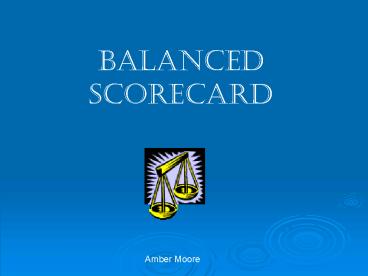Balanced Scorecard - PowerPoint PPT Presentation
1 / 13
Title:
Balanced Scorecard
Description:
The Balanced Scorecard is a management tool that provides stakeholders with a ... Helps managers focus on performance metrics ... Sanjoy Bose, Keith Thomas. ... – PowerPoint PPT presentation
Number of Views:61
Avg rating:3.0/5.0
Title: Balanced Scorecard
1
Balanced Scorecard
Amber Moore
2
What is Balanced Scorecard??
- The Balanced Scorecard is a management tool that
provides stakeholders with a comprehensive
measure of how the organization is progressing
towards the achievement of its strategic goals. - Enables organizations to clarify their vision and
strategy and translate them into action. - Helps managers focus on performance metrics while
balancing financial objectives with customer,
process and employee perspectives.
3
Balanced Scorecard
- The Balanced Scorecard
- Balances financial and non-financial measures
- Balances short and long-term measures
- Balances performance drivers (leading indicators)
with outcome measures (lagging indicators) - Leads to strategic focus and organizational
alignment.
4
Principles of a Strategy Focused Organization
1. Translate the strategy to operational
terms. 2. Align the organization to the
strategy. 3. Make strategy everyones job. 4.
Make strategy a continual process. 5. Mobilize
change through executive leadership
5
The Strategy Focused Organization
Mission What we do Vision What we aspire
to be Strategies How we accomplish our
goals Measures Indicators of our progress
6
Balanced Scorecard
- The balanced scorecard suggests that we view the
organization from four perspectives, and to
develop metrics, collect data and analyze it
relative to each of these perspectives - -The Learning and Growth Perspective
- -The Business Process Perspective
- -The Customer Perspective
- -The Financial Perspective
7
(No Transcript)
8
The Learning Growth Perspective
This perspective includes employee training and
corporate cultural attitudes related to both
individual and corporate self-improvement to
achieve our goals and accomplish core activities,
we must learn, communicate and work
together. -Tries to reverse brain-drain -Empha
size that 'learning' is more than 'training,
includes things like mentors and tutors within
the organization, communication and technological
tools. -Performance Indicators -Investment
Rate -Illness rate -Internal Promotions
-Employee Turnover -Gender/Racial Ratios
9
The Business Process Perspective
- This perspective refers to internal business
processes to satisfy our customers, in which
business processes must we excel? - Two types of Business Processes can be
identified - 1. Mission-oriented processes
- 2. Support processes
- -Performance Indicators
- -Number of Activities
- -Opportunity Success Rate
- -Accident Ratios
- -Defect Rates
10
The Customer Perspective
- This perspective emphasized the importance of
customer focus and customer satisfaction to
achieve our vision, what customer needs must we
serve? - Look at the Long term position, not just the
short term. - Performance Indicators
- -Delivery Performance to Customer - by Date
- -Delivery Performance to Customer - by Quantity
- -Customer satisfaction rate
- -Customer retention
11
The Financial Perspective
- To satisfy our customers, what financial and
regulatory objectives must we accomplish? - -Timely and accurate funding data will always be
a priority - Also included in this category is additional
financial-related data, such as risk assessment
and cost-benefit data. - Performance Indicators
- -Cash flow
- -ROI
- -Financial Result
- -Return on capital employed
- -Return on equity
12
Why Use Balanced Scorecard?
- To achieve strategic objectives.
- To provide quality with fewer resources.
- To eliminate non-value added efforts.
- To align customer priorities and expectations
with the customer. - To track progress.
- To evaluate process changes.
- To continually improve.
- To increase accountability
13
References Used
The Balanced Scorecard Institute
http//www.balancedscorecard.org/ Applying the
balanced scorecard for better performance of
intellectual capital. Sanjoy Bose, Keith Thomas.
Journal of Intellectual Capital Oct2007, Vol. 8
Issue 4, p653-665, 13p http//www.valuebasedmana
gement.net/methods_balancedscorecard.html































